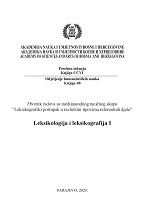LEKSIKOGRAFSKI POSTUPAK U TRETMANU NJEMAČKIH PARONIMA U DVOJEZIČKOM RJEČNIKU
LEXICOGRAPHIC TREATMENT OF GERMAN PARONYMS IN A BILINGUAL DICTIONARY
Author(s): Minka Džanko, Alma Čović-Filipović
Subject(s): Language studies, Theoretical Linguistics, Lexis, Semantics, Sociolinguistics, South Slavic Languages
Published by: Akademija Nauka i Umjetnosti Bosne i Hercegovine
Keywords: bilingual dictionary; paronyms; entry; equivalent; semantic distinction;
Summary/Abstract: In the process of creating a contemporary, universal bilingual Bosnian-German dictionary, a number of lexical-semantic challenges emerged. One of them is the occurance of paronyms which are defined in the literature quite differently. Following Storjohannʼs (2021a, 2021b) work on German paronyms, in this paper we define paronyms as formally, phonetically and/ or semantically similar words that may have the same etymological root (e.g. formal - formalistisch, kindisch - kindlich). The previous research showed that paronymic pairs are a source of uncertainty for both native speakers and learners of German as a foreign language due to their semantic and phonetic similarity. However, the existing Bosnian-, Croatian-, or Serbian-German bilingual dictionaries rarely treat this phenomenon neither explicitly, with a note or a separate window, nor implicitly - by taking into account different conceptual referential aspects of the meaning and use of paronyms. The goals of this work are: 1. to offer concrete solutions for a lexicographic treatment of paronyms in the microstructure of the Bosnian-German universal dictionary; 2. to encourage further research into this phenomenon in order to fill an evident gap in domestic and bilingual lexicography. Data comes from the online paronym dictionary of German Language Institute Mannheim, in which their meaning structures are clearly delineated and schematically shown. We investigate their lexicographic presentation in existing bilingual dictionaries and propose more adequate lexicographic treatment in order to offer a more appropriate equivalent. For example, the entry bezbolno (painlessly) occurs in the existing dictionaries with the equivalents schmerzlos and schmerzfrei, suggesting that these two words are synonyms and can be used equally in any context in the German language, even though they are actually paronyms.
Book: LEKSIKOLOGIJA I LEKSIKOGRAFIJA I
- Page Range: 24-44
- Page Count: 21
- Publication Year: 2022
- Language: Bosnian
- Content File-PDF

